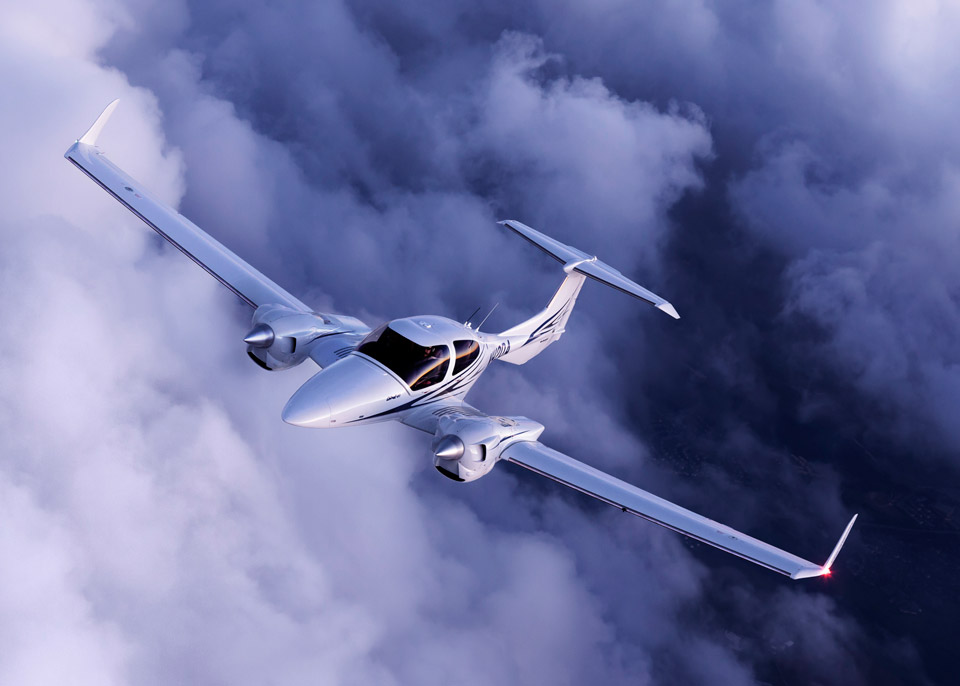
Forget everything you know about operating an airplane. Forget about engine management, rough takeoffs and landings, inherent safety risks, and twin-engine operations—oh, and half of the performance charts. The swashbuckling image of the pilot barely surviving as he wrestles the airplane to the ground is gone. In its place is a smart, savvy cockpit manager who oversees complex systems with a few simple button pushes that take him anywhere he wants to go, in comfort and unique style. The new Diamond DA42-VI is on the leading edge of light airplane technology.
For some, airplanes should be sexy. For others, fast. And for some, fun. Diamonds are for the practical among us. With more than 20 improvements over the DA42 NG, the new DA42-VI is the ultimate in practicality. It’s not blazingly fast, but you will get there surprisingly quick. It won’t carry everything but the kitchen sink, although it will do just fine with full fuel, two people, and bags. The inside isn’t roomy, but the new seats are cool and comfortable. Nothing the airplane does is flashy, but everything it does, it does very well. When it comes time to sign the big check, this airplane prompts the head to drive the pen.
Beginnings
The DA42-VI is the fourth major version of Diamond’s twin-engine, carbon-fiber airplanes. It’s built in Austria at the parent factory (as opposed to Canada, where the DA40s destined for North America and a few other products are built). The airframe evolved from the early Diamond gliders, so cabin comfort suffers a bit as a trade for excellent aerodynamic efficiency.
Many of the changes come from aerodynamic tweaks. The engine nacelles are new, the propellers are new, and the TKS ice-protection system’s panels are flush-mounted—as are the 200 or so screws and the nose baggage compartment doors. The rudder has a different form factor that also reduced VMC by five knots, and the aileron hinges are now covered by a fairing. The empty weight actually came down by 88 pounds. Depending on altitude, the airplane is about 15 knots faster than the DA42 NG.
The interior features a redesigned overhead environmental console, and special leather seats that don’t get hot; sun visors are optional extras. To those familiar with other Diamond products, the seats will be worth the cost. Describing a traditional Diamond seat as firm is being charitable; hard is more accurate. Thanks to an awakening in the industry toward proper interior appointments, buyers have the option for seats that recline and have lumbar support.
The real story of the DA42-VI, however, is the engines. Diamond bet its future on diesel engine technology, and it seems to be paying off. Once you get past the decidedly American idea that only trucks use diesel engines—and forget the unremarkable history of car engines in airplanes—the Mercedes-Benz-derived AE300 (officially the E4-C on the DA42-VI), with its full authority digital engine control (FADEC), is a highly promising technology that meshes beautifully with this airframe. Without question, Diamond will need to educate potential consumers on the engine as traditionally minded pilots strain to break free from their much-beloved Lycomings and Continentals. Make a pro/con list, and the benefits of the AE300 come in to focus. On the pro side, the engines sip fuel. High-speed cruise at 92 percent power burns about 16.5 gallons per hour total. Throttle back for more economy and the burn drops to about 10.5 gallons total. Oil changes are recommended every 100 hours as opposed to the usual 25 or 50 hours. And the FADEC translates to electronic engine diagnostics. According to John Armstrong, a Diamond sales representative, there have been no in-flight engine failures with more than 200,000 hours in service. The overhaul currently is priced at about $22,000. Jet fuel is cheaper than avgas. And that whole 100LL replacement concern? AE300 owners are tone-deaf to the entire thing.
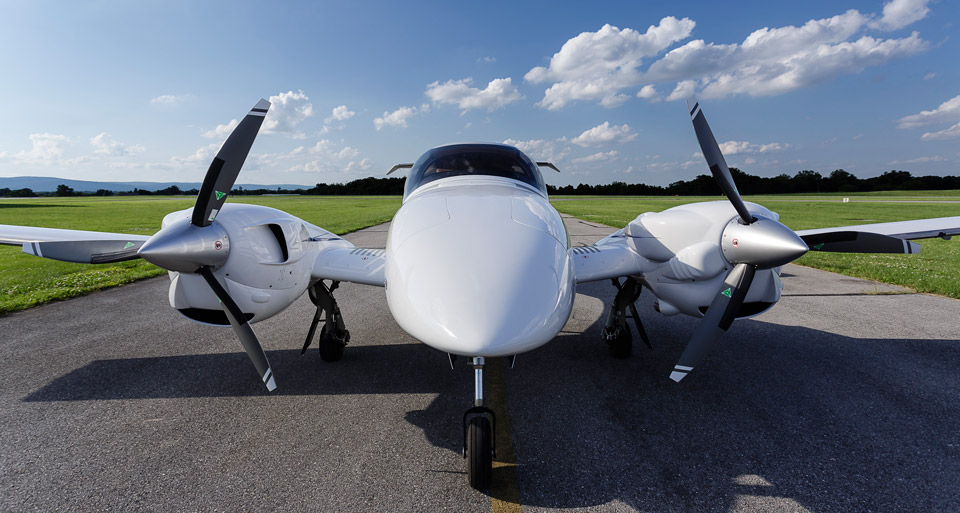
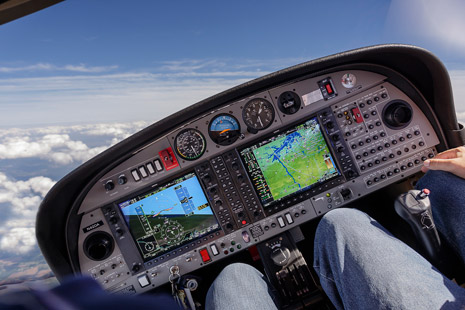
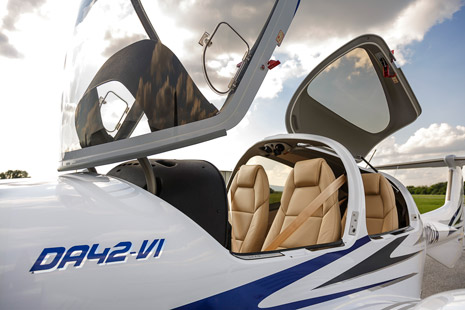
The con list is shorter. The 168-horsepower engines utilize a cast-iron block, so they’re heavy. They’re produced in Austria, so while the service and support network is coming together in the United States, it will be harder to find someone to work on the Austro than it would be for a “traditional” engine. Another potential negative is the overhaul time, which now stands at 1,500 hours. That has increased 500 hours in the past year, and Diamond plans to get it to 2,000 hours soon. The high-pressure fuel pump is also life limited to 600 hours.
Unquestionably, the biggest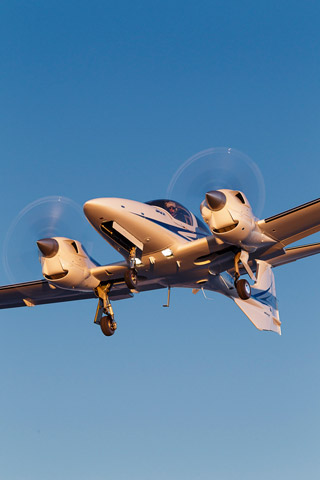 advantage of the engine is the electronic control. It’s impossible to grasp the scope of how much this changes the way you fly until you try it. From start-up to shutdown, everything about operating these engines is different. That’s not a euphemism for clumsy and awkward—they are different in the sense that the learning transfer is more appropriate from your Chrysler than your Cessna.
advantage of the engine is the electronic control. It’s impossible to grasp the scope of how much this changes the way you fly until you try it. From start-up to shutdown, everything about operating these engines is different. That’s not a euphemism for clumsy and awkward—they are different in the sense that the learning transfer is more appropriate from your Chrysler than your Cessna.
Start-up goes like this: flip on the avionics master. Wait for the Garmin G1000 to boot up. If the engine is cold, the glow plug indication will come on and you wait a second. If the engine is warm, it’s ready immediately. Turn on the engine master switch and turn the key. Do the same on the other engine. That’s it. And they start every time. There’s no such thing as a hot start, a cold start, or a flooded start—everything is a normal start. Power is controlled with two large throttles in the center console that are not unlike turbine condition levers. The runup is equally easy. Simultaneously push and hold the two electronic engine control buttons and wait for the engines to automatically power up, do a feather test, and then spool down again. It takes around five seconds.
In-flight engine management also is different. Concepts such as lean of peak, rich of peak, and the best throttle and rpm setting are gone. You pick which is primary—speed or fuel burn—and then set a percentage. Think about driving and you get the picture. In a car, you slow down to save gas, or stomp on it to get somewhere. Obviously we all do this in all sorts of airplanes, but there are so many variables that you practically need to go to test pilot school to figure it all out. With the DA42-VI, just look at the laughably simple performance chart and pick a number. Want to fly based on fuel burn? Climb, cruise, or descent—it doesn’t matter. Just set the power percent to get that number and leave it. If speed is primary, pick the best altitude and go there.
Engine shutdown is equally simple. Turn off the avionics master and flip the engine masters down. The props will windmill for a few cycles and then stop dead, without a tooth-rattling shake. Extrapolate that out to engine shutdowns in flight and you can see that safety is greatly increased in both training and emergency situations by the simplicity of the system. Shutting down an engine is done by flipping a switch. To start it again, either slow down to 100 knots, flip on the master, and turn the key—or enter a dive above 125 knots and turn on the master. The first two steps of identify and verify still are important, but the engines feather automatically.
If you’re going to increase multiengine safety, single-engine performance must also be good, and in that regard, this airplane is a champ. At maximum gross weight and standard conditions, it will climb to about 12,000 feet. When the airplane is light or your bad luck strikes in the winter, it’s certified to climb to 18,000 feet on one engine.
Time to fly
We flew Dave Passmore’s DA42-VI for this report, the first airframe imported into North America. Passmore decided to go all-out on his Diamond, ordering almost every option on the list—and a few that weren’t. It features TKS, air conditioning, a top-end interior, AmSafe seatbelt airbags, XM weather, an Avidyne active traffic system, synthetic vision, electrically adjustable rudder pedals, extended-range fuel tanks, oxygen, and sun visors.
It’s natural to want to compare the DA42-VI to the DA40, and in that sense the twin is a much nicer airplane. It’s more stable; the props create more drag to make quick descents easier (and there’s no shock cooling with liquid-cooled engines); and with the trailing-link gear, it lands nicer. The only place the twin loses out to its single-engine brother is in roll; it’s both heavier and slower about the longitudinal axis. But with both having virtually the same aileron (0.1 square feet larger on the twin), and because the DA42-VI is heavier and has a longer wing, that’s to be expected. Otherwise, with the easy engine management and practically the same panel, pilots expecting a challenging transition from the DA40 to the DA42-VI will be sorely disappointed.
Passmore briefed me on how to operate the engines in about 10 minutes and then we did some speed tests, airwork, and a few landings. At gross weight, a little above sea level, and about 25 degrees Fahrenheit above standard, we climbed at 1,300 feet per minute up to 11,500 feet. The turbochargers help the AE300 produce full continuous power of 92 percent to a bit beyond 16,000 feet. We leveled off heading VFR eastbound and let the speed build up at the high power setting. A few minutes later we stabilized at 188 knots on 16.5 gallons an hour total. Trying an economy cruise, we reduced power to a more reasonable 10.3 gallons an hour total, which translated to 60 percent power and 154 knots. Both speeds were around four knots faster than book.
I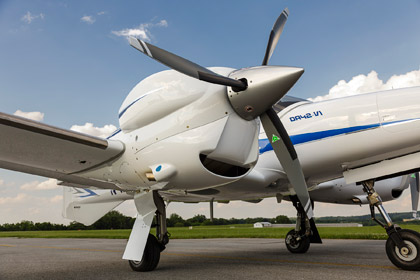 n airwork the airplane is docile and predictable. Stalls are crisp, but cordial. Pilots who haven’t flown the seat-mounted center stick will spend a little time adjusting, but not much. Visibility is, of course, brilliant, which makes it all the more enjoyable to take in the great feeling of being a “big airplane” pilot and watching the props spin on the wing-mounted engines. One unusual trait of that engine and propeller combination is that the cabin is refreshingly quiet. And DA40 pilots who have suffered with wind-tunnel-like air vents will be pleased at the normal volume of the DA42-VI’s cooling setup.
n airwork the airplane is docile and predictable. Stalls are crisp, but cordial. Pilots who haven’t flown the seat-mounted center stick will spend a little time adjusting, but not much. Visibility is, of course, brilliant, which makes it all the more enjoyable to take in the great feeling of being a “big airplane” pilot and watching the props spin on the wing-mounted engines. One unusual trait of that engine and propeller combination is that the cabin is refreshingly quiet. And DA40 pilots who have suffered with wind-tunnel-like air vents will be pleased at the normal volume of the DA42-VI’s cooling setup.
Landings are enjoyable and envy-inducing, thanks to the trailing link gear and mid-80s approach speed. I had a tendency to want to land with a little bit of power, which might not be a bad thing, given the air brake effect of the propellers at idle.
It’s not a perfect airplane, not that there is such a thing. Owners may find a few minor annoyances, such as a limitation on using the air conditioning above 10,000 feet, and air conditioning and seat controls that aren’t easy to reach. Flight schools could be deterred by the prohibition on intentionally shutting down an engine below 3,000 feet or above 10,000 feet. And even then, an engine can’t be shut down for more than two minutes, which makes for rushed single-engine approaches.
Perhaps a bigger issue is that light twin-engine airplanes have an image problem. The used values are in the tank, and the few other new twins currently available are expensive to buy and operate. Even the basic question of whether or not two engines really is safer continues to turn people away. That said, Diamond has an opportunity to create new twin owners. Passmore said he was seriously considering a Cirrus SR22 and a Cessna Corvalis, both of which are faster, roomier, and less expensive (depending on options) than the DA42-VI. As a retired technology professional, the advanced systems appealed to him. Diesel doesn’t scare him—he drives a diesel car. The twin might have cost him a little bit more, but he has a unique airplane with the additional safety of a second engine; total fuel burns like those of many singles; and a strong, reliable airframe. “Forget about the twenty-first century,” he said. “We’ve finally made it to the twentieth.”
Email [email protected]
Pick a twin
Diamond distributor Dominion Aircraft Service’s John Armstrong is trying to pick up on the customer experience where Diamond is trailing off. Taking a cue from top European carmakers, Armstrong has developed an optional European delivery experience. Owners who want to understand more about the airplane’s geographical inspiration, and get in a fun flying vacation to boot, can now take delivery of a new DA42-VI at the Diamond factory in Austria. No time to cross the pond? Armstrong will deliver the airplane to the hangar of your choice.
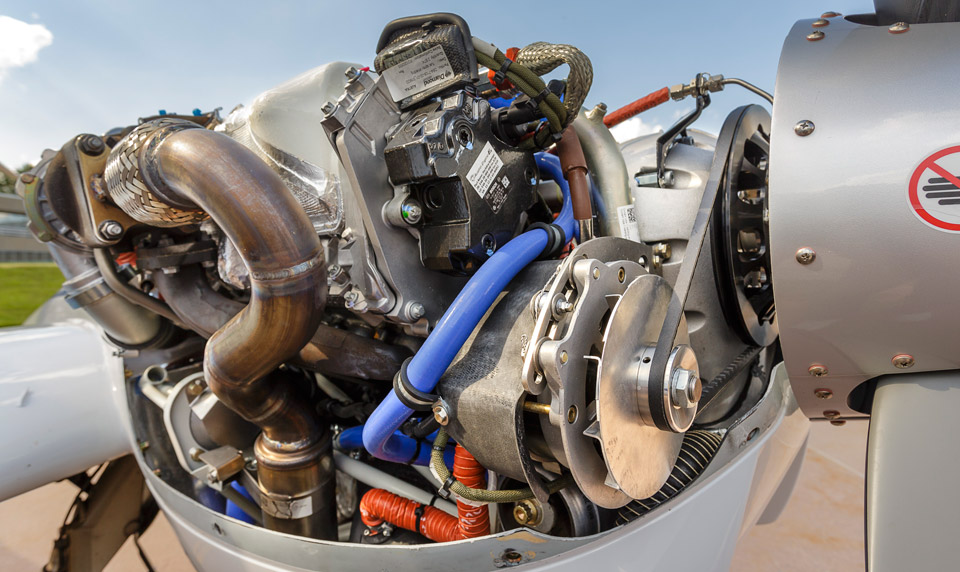
SPEC SHEET
Diamond DA42-VI
BASE PRICE: $731,198 | price as tested: $938,418
Specifications
- Powerplants | 2 Austro Engine E4-C (AE300), 168 hp ea
- Recommended TBO | 1,500 hr
- Propellers | MT Propeller MTV-6-R-CF
- Length | 28 ft 1 in
- Height | 8 ft 2 in
- Wingspan | 44 ft 6 in
- Wing area | 175.3 sq ft
- Wing loading | 23.9 lb/sq ft
- Power loading | 12.5 lb/hp
- Seats | 4
- Cabin length | 8 ft 6 in
- Cabin width | 3 ft 10 in
- Empty weight | 3,109 lb
- Empty weight, as tested | 3,250 lb
- Max ramp weight | 4,207 lb
- Max gross weight | 4,189 lb
- Useful load | 1,080 lb
- Useful load, as tested | 939 lb
- Payload w/full fuel | 568 lb
- Payload w/full fuel, as tested | 427 lb
- Max takeoff weight | 4,189 lb
- Max landing weight | 3,979 lb
- Zero fuel weight | 3,891 lb
- Fuel capacity, std | 52 gal (50 gal usable)
- 348.4 lb (335 lb usable)
- Fuel capacity, w/opt tanks | 79.4 gal (76.4 gal usable)
- 532 lb (512 lb usable)
- Oil capacity, ea engine | 7.4 qt
- Baggage capacity | 166 lb
Performance
- Takeoff distance, ground roll | 1,309 ft
- Takeoff distance over 50-ft obstacle | 2,347 ft
- Max demonstrated crosswind component | 25 kt
- Rate of climb, sea level | 1,203 fpm
- Single-engine ROC, sea level | 284 fpm
- Max level speed, sea level | 169 kt
- Max level speed, 14,000 ft | 187 kt
- Cruise speed/endurance w/45-min rsv, std fuel
- (fuel consumption, ea engine)
- @ 75% power | 168 kt/3.1 hr
- 12,000 ft | (43.5 pph/6.5 gph)
- @ 65% power | 157 kt/3.8 hr
- 12,000 ft | (36.8 pph/5.5 gph)
- @ 55% power | 144 kt/4.5 hr
- 12,000 ft | (31.8 pph/4.75 gph)
- Max operating altitude | 18,000 ft
- Service ceiling | 18,000 ft
- Single-engine service ceiling | 18,000 ft
- Landing distance over 50-ft obstacle | 2,029 ft
- Landing distance, ground roll | 1,212 ft
Limiting and Recommended Airspeeds
- VMC (min control w/critical engine inoperative) | 71 KIAS
- VX (best angle of climb) | 77 KIAS
- VY (best rate of climb) | 90 KIAS
- VYSE (best single-engine rate of climb) | 85 KIAS
- VA (design maneuvering) | 122 KIAS
- VFE (max flap extended) | 113 KIAS
- VLE (max gear extended) | 188 KIAS
- VLO (max gear operating)
- Extend | 188 KIAS
- Retract | 152 KIAS
- VNO (max structural cruising) | 151 KIAS
- VNE (never exceed) | 188 KIAS
- VR (rotation) | 76 KIAS
- VS1 (stall, clean) | 68 KIAS
- VSO (stall, in landing configuration) | 62 KIAS
For more information: Contact Diamond Aircraft, www.diamondaircraft.com, 519-457-4000
All specifications are based on manufacturer’s calculations. All performance figures are based on standard day, standard atmosphere, sea level, gross weight conditions unless otherwise noted.
Extra
As impressive as these book efficiency numbers are, our test showed the airplane outperforms these numbers.
(prices subject to change based on current exchange rates)



